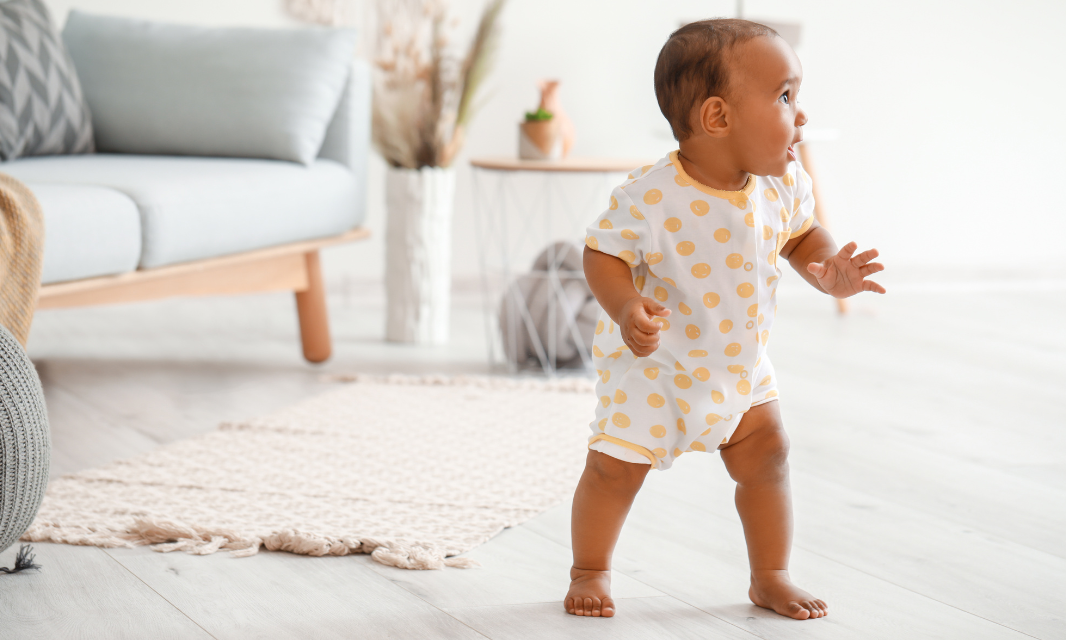
09 May Encouraging Baby Walking Development
Walking is one of the major milestones we look for in our babies. Typically, walking is achieved between 10 and 18 months. Baby walking development can vary greatly from child to child, so it’s really important not to compare your baby to others, as everyone develops at their own pace. However, it is important to continue monitoring for delays in milestones and to get the advice of a qualified healthcare professional if you have any concerns regarding your baby’s development.
Mostly, the order of our babies’ development happens because they cannot do one thing without the other. For example, crawling is imperative to develop strength through the core and hips that your child requires for walking. Physios, parents, and carers can use this knowledge to actively support baby walking development by providing targeted exercises and activities that build strength and improve balance.
Activities/Exercises to Encourage your Baby to Walk
High Kneeling – Kneeling on both knees with bottom lifted off feet, playing with toys at a bench about chest height. This helps to encourage hip strengthening and starts working the core muscles in an upright position.
Pull to stand – It goes without saying you need to be able to stand before you can walk. Pulling to stand has the added bonus of helping to strengthen the legs as your child pushes up.
Prolonged standing play – Helps them have the strength and endurance in their leg muscles to walk and encourages them to progress via reducing their trunk leaning on the surface and ability to rotate away or taking a hand off to play.
Squat at bench – Squatting whilst holding onto something for support. Squatting in babies and toddlers has the same benefits as squatting in adults. To strengthen the leg muscles. To encourage squatting, play a game where your child has to move a toy from the ground to the bench. Or pass your child a toy at about their knee height. The lower the toy is, the harder it is.
Weight shift and Cruising – With your child standing at a bench, start by placing toys just out of reach so they have to shift their weight to one leg. Once they master this place toys further away, so your child has to take some side steps and start cruising.
Walking with reduced support – Walking at a bench or something solid feels quite safe for your child. They may be reluctant to go from 100% support to no support. Gradually reducing support whilst walking by using things such as hula-hoops and having them hold one end of a toy, and you hold the other, is a great way to encourage your child to move away from the bench.
Another great way to reduce support is to have your child use the wall for support. The upright wall provides less support than a bench but more support than some of the options listed above.
Standing without support – Working on standing balance in the middle of the room. Distract your child by having them play with toys at chest height. Balance is a very important skill to master. Some children will master it before walking, some will master it whilst learning to walk.
Encouraging Baby Walking Development with the Help of a Paediatric Physiotherapist
Above are some great exercises to try. However, if you are having a lot of trouble encouraging your child to walk, they may require further assessment to ascertain why they may be struggling to walk. Our physiotherapists at Western Paediatric Physiotherapy are skilled in assessing and addressing issues that may be preventing progress in baby walking development. We can also provide recommendations if further input from a paediatrician is required.
If you are concerned about your child’s development or they are getting close to 18 months and not walking, please do not hesitate to contact Western Paediatric Physiotherapy for a consultation.

Sorry, the comment form is closed at this time.